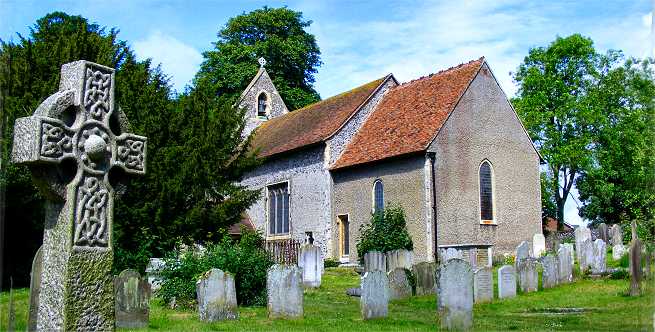
The old Blessed St Mary's Church is set in a burial ground in Church Street at Upper Walmer. Once the local parish church, it was superseded with the building of the "new" much larger St Mary's on the eastern side of the Dover Road in 1887-88. However, communion services are still held in the old church every Thursday morning.
The tiny church features rough flint walls with a single aisle, nave and chancel. It is believed to have been originally built around 1120 as a chapel for the d'Auberville family who came with the Norman Conquest. The ruins of their original Manor House can be seen from the churchyard and are now an Ancient Monument. A yew beside the church porch is estimated to be 1,000 years old. The Duke of Wellington regularly attended services in the church and is rumoured to have had a tendency to nod off if the sermon proved too long.
English Heritage lists the building as Grade II*. It considers it was built around 1120 with an Early English chancel, was extended in the 17th century and again around 1826 (although these phases do not survive). It was further altered and partly rebuilt in 1898. As well as the church's importance through its significant 12th century and later medieval features, English Heritage highlights the strong visual and historical relationship with the ruins of the moated manor house of Walmer Court and the historic association with the Duke of Wellington in his role as Lord Warden of the Cinque Ports and whose hatchment hangs on the nave wall.
English Heritage provides an amount of information on the construction, special features and history of the building on its website at http://list.english-heritage.org.uk/ resultsingle. aspx?uid=1251215. It describes the layout as a "simple plan comprising nave, lower chancel and south porch" with "flint with stone dressings, roughcast render to the chancel and a clay tile roof" the main materials used in its construction.
Outside there is a bellcote to the west end and a late C19 Norman style doorway to south porch. Although most windows have been altered or renewed, the south side of nave has one small Norman window to the west of porch, and a large, late-medieval three-light window to the east. Among the interior features listed are: a 12th-century chancel arch of considerable scale for a small church, traces of medieval wall painting above the arch on the nave side, a 14th-century trefoil-headed piscina on the south wall of the nave, two niches in the chancel wall (one an aumbry, the other a credence), and the late 19th-century King-post roof. There are also numerous monuments, principally early-mid 19th-century neo-Classical wall tablets, and six hatchments including one of the Duke of Wellington, Lord Warden of the Cinque Ports from 1829-52, which was carried in front of his cortege after his death at Walmer Castle.
For the church's history, English Heritage dates it from its construction by the d'Auberville family around 1120, probably as the chapel close to their Walmer Court manor house. In the late 17th century the church was enlarged, rather unconventionally, by the addition of a galleried nave on the north side of the existing nave, thus reorientating the church on a north-south axis and placing the altar at the southern end. But the extension was demolished in 1898, the church conventionally reorientated, and the nave north wall reinstated. The Duke of Wellington was a regular worshipper at the church when in residence at Walmer Castle. It ceased to be the parish church when the new church of St Mary was built in 1887-8.
For photographs of The Blessed St Mary Church, please see our Upper Walmer photo album.
Details of graves or memorials for Commonwealth servicemen in the Blessed St Mary churchyard are available on the Commonwealth War Graves Commission website.